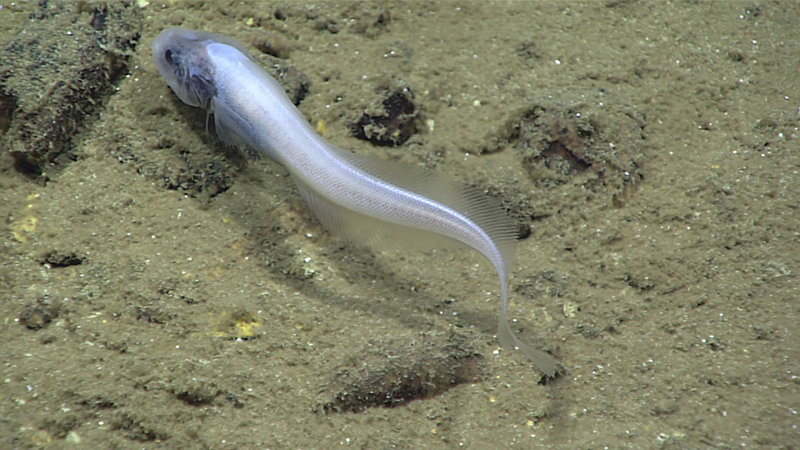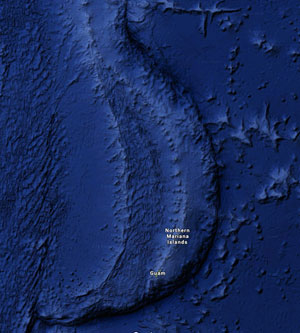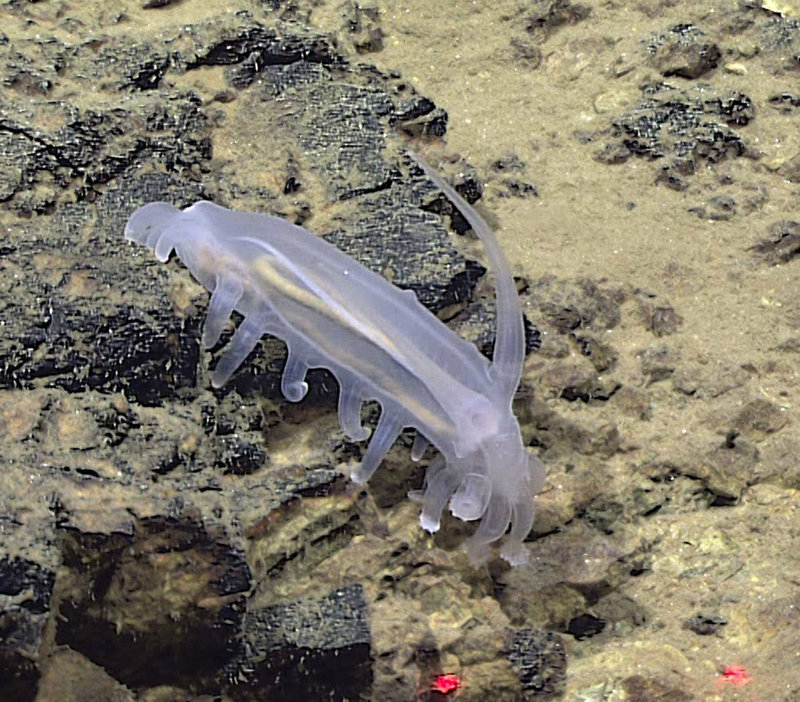
By Mackenzie Gerringer - University of Hawaii
Jeff Drazen - University of Hawaii

Cusk eels (family Ophidiidae) are common in the deep sea, like this one of the genus Leucicorus. Image courtesy of NOAA Office of Ocean Exploration and Research, 2016 Deepwater Exploration of the Marianas. Download larger version (jpg, 1.1 MB).
Throughout this expedition, the scientists have seen amazing biology and geology in the deep sea around the Mariana Islands. These dives have seen the edges of the world’s most famous subduction feature – The Mariana Trench, which houses the ocean’s deepest point, Challenger Deep at 10,989 meters. That's even deeper than Mount Everest is tall! It would take 43,600 pieces of spaghetti laid end to end to get to the bottom of the Mariana Trench. The dive in Sirena Canyon observed the edge of the trench at depths to ~5,000 meters and we plan to do more soon!
The Mariana Trench is one of about 30 subduction zones that make up the hadal zone, depths 6,000 – 11,000 meters. Trenches offer a distinct deep-sea habitat for a number of cool critters.

The Mariana Trench, satellite view from Google Maps. Image courtesy of Google Maps. Download image (jpg, 59 KB).
The deepest parts of the ocean are named 'the hadal zone' after the Greek underworld Hades. Scientists decided to name this zone after Hades because it’s the underworld of the ocean – with harsh conditions. But these conditions are what is normal for the animals down there. They like the cold, the dark, and the high pressure and are quite happy to live their lives way down deep. And they're not monsters of the underworld at all - many can be quite beautiful and certainly interesting, like those you can see in this video .
The trench is a very different world than what we experience. It's always dark there, so instead of using vision to orient themselves, the animals living there are able to smell their surroundings and sense vibrations in the water in order to understand their environment, find food, and stay safe from predators.
It's also cold, barely above freezing, and the pressure is amazingly high. The pressure at the bottom of the Mariana Trench is the same as 1000 elephants standing on top of a taxi! This means that only very specialized animals and microbes that can handle the pressure can live in trenches.

Translucent seapig with long antennae-like projections. We are unsure if this is in the genus Amperima or Peniagone. Image courtesy of NOAA Office of Ocean Exploration and Research, 2016 Deepwater Exploration of the Marianas. Download larger version (jpg, 615 KB).
On the Sirena Canyon dive we observed translucent seapigs with long antennae-like projections. This group of sea cucumbers has been incredibly successful in the trenches and can be really abundant at deeper depths.
A particularly cool trench resident is the hadal snailfish , a little fish with clear skin that live in the very deep parts of the sea. These have a very different appearance than what regular viewers of the Deep Discoverer dives would expect from deep-sea fishes. This family of fishes have found great success in trenches worldwide, including the Mariana Trench.
Although the trench is deep and feels far away, it is connected to the rest of the ocean. Almost all of the food for the animals down there comes from the surface - little particles fall and bring nutrients down, and larger things like a whale that has died and sunk can feed a deep-sea community for up to 100 years.
Because it's all connected, a healthy deep sea requires a healthy ocean. This includes making sure trash doesn't end up in the water (plastics and other garbage can go all the way down to the trench!) and supporting marine protected areas.
For more information on deep-sea trenches, what lives there, and how scientists explore them, check out http://web.whoi.edu/hades/ or this link for 10 things you may not know about deep-sea trenches.